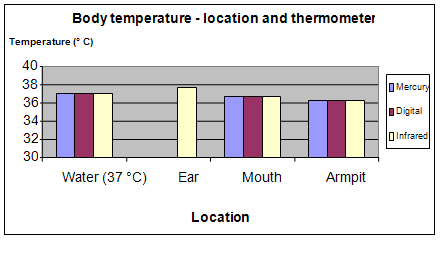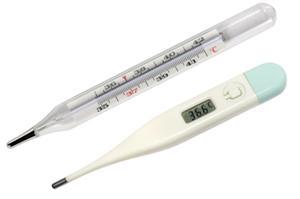| Complexity level: | 6 |
| Project cost ($): | 80 |
| Time required: | 1 hour to prepare, 1 hour for science fair project |
| Material availability: | Easily found |
| Safety concerns: | Be extremely careful with glass mercury thermometers to avoid breakage/spillage of the mercury, which can be extremely toxic/dangerous. Adult assistance is required. |
Hypothesis
Readings using different types of thermometers will be the same but different readings will be obtained from different parts of the body.
Overview
Body temperature
Body temperatures are a result of our bodies producing, maintaining and dissipating heat. When our body heats up, the blood capillaries under our skin will expand resulting in an increase in blood flow - this allows more heat to be carried from within our body to the surface of our skin. This is where the heat is released/dissipates - resulting an reduction of the body temperature. In cold climates, the blood vessels contract restricting the flow of blood to the skin surface, allowing for increased heat retention.
A normal body temperature is about 37 °C and this temperature may vary by about 0.6 °C depending on the time of the day. The temperature measured at our body cavities (eg. inside the ear or rectum) is normally up to 0.6 °C higher than oral temperature reading. Temperatures taken at the armpit or the skin, will be up to 0.6 °C lower than the oral temperature reading. Therefore different parts of the body will give different temperature readings.
Temperatures are taken from inside the mouth and under our armpits with a mercury or digital thermometer. Temperatures at the forehead are normally measured using a plastic thermal strip. The temperature is measured at the tympanic membrane inside the ear using an infrared thermometer.
Scientific Terms
Materials
The materials required for the science fair project experiment:
- 1 participant
- a glass mercury thermometer
- a digital thermocouple thermometer
- an infrared thermometer
- a hot plate
- a beaker
- tap water
Procedure
1. For this science fair project, the independent variable is the type of thermometer used - mercury or glass, a digital thermocouple thermometer and an infrared thermometer. The dependent variable is the temperature measured using the 3 thermal devices. This is determined by using the thermometers to measure the temperature. The constants (control variables) are the room temperature and the time of the measurements.
2. The beaker is filled with water and placed on the hot plate. Its temperature is then raised and maintained at 37 °C. The temperature of the water is taken using the mercury glass thermometer, a digital thermocouple thermometer and an infrared thermometer. The observed temperatures are recorded in the table given below.
3. The infrared thermometer is used to take the participant’s temperature inside the ear and the reading is recorded in the table below.
4. The temperature inside the participant’s mouth and under his armpit, is taken using the mercury glass thermometer, a digital thermocouple thermometer and an infrared thermometer. The readings taken using the infrared thermometer must be taken quickly because once the mouth is opened or the arm raised, the temperature will begin to fall.

Results
The results showed that readings taken with all 3 types of thermometers were the same. The temperature taken inside the mouth was higher than the armpit’s but lower than the temperature taken inside the ear.
|
Thermometer type |
Body temperature at different locations ( °C) |
|||
|
Water (37 °C) |
Ear |
Mouth |
Armpit |
|
|
Mercury |
37.0 |
- |
36.7 |
36.3 |
|
Digital |
37.0 |
- |
36.7 |
36.3 |
|
Infrared |
37.0 |
37.7 |
36.7 |
36.3 |
The graph below represents the results of our science project experiment.

Conclusion
The hypothesis that temperature readings taken with different types of thermometers will be the same, but that different readings will be obtained from different parts of the body, is proven to be true.
Our body temperature may change throughout the day due to many reasons such as hormonal changes, the type of activity or the outdoor temperature. When our body temperatures exceed 38 °C, we are deemed to be having a fever. Fevers may be caused by infections, medication, trauma or other medical conditions.
Also consider
To improve the reliability and accuracy of our results, a larger sample of participants should be used.
This science fair project may be repeated, this time, at different times of the day, to compare the body temperature changes.
Do you think animals (eg dogs, cats) will demonstrate the same body temperature characteristics
References
Normal human body temperature - http://en.wikipedia.org/wiki/Normal_human_body_temperature
Body temperature - http://firstaid.webmd.com/body-temperature

